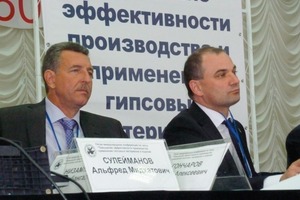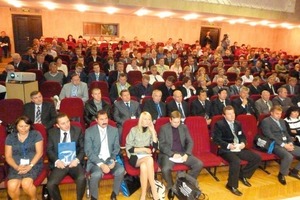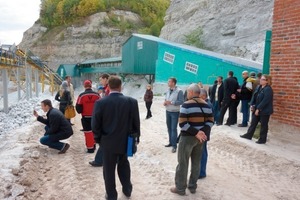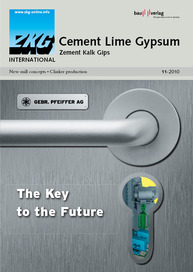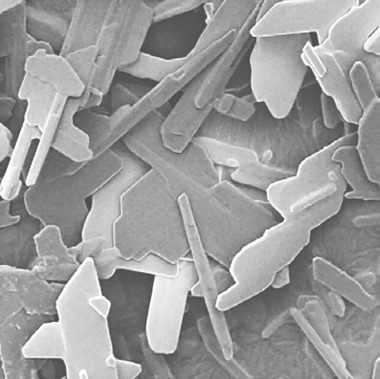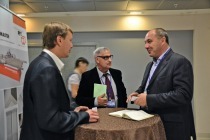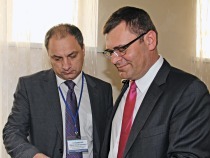Increased interest in gypsum as a building material in Russia
5th International Gypsum Conference of the Russian Gypsum Association, Kasan/Russia (08.-10.09.2010)
The 5th International Gypsum Conference, organized by the Russian Gypsum Association, took place in Kasan, Russia, on 08.-10.09.2010. The organizers, Juri Gontsharov (Chairman of the Gypsum Association) and Prof. Dr. Burjanov (Conference Secretary) had succeeded in interesting virtually all Russia’s producers of calcium sulfate binders in this conference (Fig. 1). Not only the major companies but also experts from the smaller plants were present. In total about 250 conference delegates from 17 countries made use of the outstanding opportunity to make new contacts or extend existing ones (Fig. 2).
The extraordinarily positive response to the conference was also reflected in the extensive lecture programme. About 40 of the contributions printed in the conference proceedings (almost entirely in Russian) were presented. The emphasis was on:
– action of additives during the hydration process,
– modified gypsum binders and binder systems that contain calcium sulfate,
– structural elements based on calcium sulfates, and methods of construction,
– utilization of recycled materials in the production of calcium sulfate building materials.
The introductory lecture by Mr. Jasko on building in the Republic of Tatarstan was followed by several plenary lectures. Prof. Rakhimov (Kasan University of Building and Construction) gave a report on general international trends and the special features of the calcium sulfate building materials sector in Tatarstan. The lecture by Prof. Jakowlew (Izhewsk University) focused on lightweight building materials based on synthetic anhydrite. This by-product from the production of hydrofluoric acid has hardly been used until now in Russia. It can be used as the basis for producing low-cost products. The lightweight aggregate used was polystyrene. The use of synthetic anhydrite for producing floor screeds leads, among other things, to substantial differences in strength. Dr Fischer (Bauhaus University, Weimar) demonstrated possible reasons for this and supported them with specific test results. Klimenko (Belogrod University of Building) examined possible ways of activating insoluble anhydrite. Partially de-watered natural gypsum with a crystal water content of 3.5 % is particularly suitable for this purpose. Various calcium sulfate phases that contain water were also discussed in the context of this work. Gypsum-cement-pozzolana binders played an important part in the comments by Prof. Korovjakov with respect to increasing the tempo of construction. Ways of raising the water resistance of calcium sulfate building materials was discussed in this connection.
Interesting topics were also to be found in the rest of the lecture programme. Dr Müller (Sika), for example, spoke about CE plasticizers. Their special feature is that they were developed for specific binders aimed at special features of particular plants (gypsum raw materials, production methods, compatibility with other additives). Plasticizers also played a part in the lectures by Vasilik (EvroChim-1), Belotto (Bozzetto Group) and Dolgorev (Dubna Institute). They spoke about the distinctive effects on strength development in calcium sulfate binders (Dolgorev) and modified binder systems (Vasilik). Prof. Pustovgar (Moscow University of Building and Construction) pointed out the effects of finely ground additions in dry premixed mortar based on calcium sulfate. Comments on the morphology of the gypsum crystals played a not inconsiderable role in other conference lectures, i.e. Förthner (Knauf) in connection with rheological properties and Hartmann (Bauhaus University, Weimar) on the influence of additives.
The lectures by manufacturers of mechanical equipment formed another focal point. New and modified technologies were presented to the large audience. Of particular interest was a “homogenizer” presented by Claudius Peters that not only homogenizes the product and reduces the residual dihydrate by using the exhaust air from the calcination process but also causes artificial ageing of the hemihydrate plaster, resulting in stable workability properties. Pfeiffer AG concentrated on roller grinding mills, and various performance parameters were explained. A lecture by Erisim Makina Ltd. (Ankara/Turkey) focused on new process engineering solutions in the production of gypsum binders and dry premixed mortars. “Pucchini Industria” gave a report on plants for producing gypsum wallboard. Particular attention was directed to the “Rapid Muro” wallboards that have a voids content of 48 % and a weight of 48 kg/m2. The Russian plant manufacturers also promoted their products during the conference (“Strommaschina” – Samara, “Ventprom” – Artjomovsk).
The organizers themselves had not reckoned on such a large number of lecture requests, which meant that the time for questions had to be very restricted. However, this did not interfere with the interchange of opinions as there was sufficient time for discussions in the breaks, at the reception and during the specialist field trips. The supporting programme with a visit to a gypsum wallboard production plant and to underground gypsum mining followed by a boat trip on the Volga was very popular with the conference delegates (Fig. 3). The warm hospitality offered by the local gypsum companies, headed by “Altyn” with Mr. Abdullin, “Araktchinskij Gips” with Mr. Galijew and “Kamsko-ustjinskij gipsovyj rudnik” with Mr. Achmetschin, was greatly appreciated. The number and content of the scientific lectures gave a clear indication that there is increased commitment in Russia to research into gypsum as a building material. The European producers of plant and additives were able to present their products and services to the Russian market. The organizers, (particularly Prof. Burjanov) and the host university (Kasan University for Architecture and Civil Engineering, Prof. Rakhimov), earned great appreciation and the special thanks of all the conference delegates for this very successful conference. Kasan was worth the journey in every respect! The next conference is expected to be held in 2012.
Information about the Gypsum Industry Association in Russia can be found at www.rosgips.ru .

